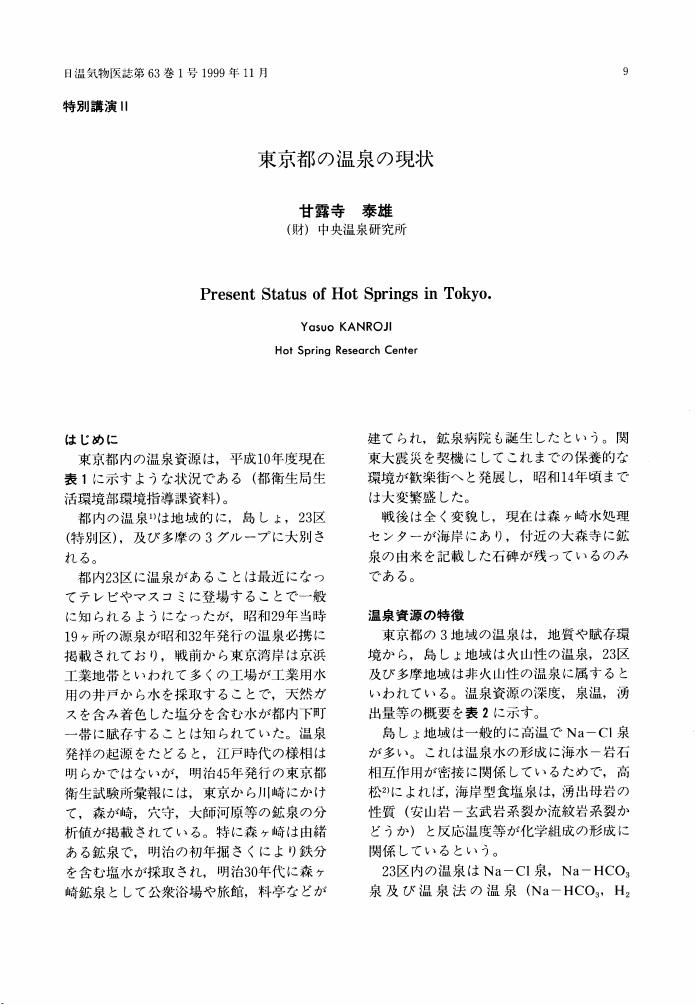1 0 0 0 OA 東京都の温泉の現状
- 著者
- 甘露寺 泰雄
- 出版者
- 一般社団法人 日本温泉気候物理医学会
- 雑誌
- 日本温泉気候物理医学会雑誌 (ISSN:00290343)
- 巻号頁・発行日
- vol.63, no.1, pp.9-12, 1999 (Released:2010-04-30)
- 参考文献数
- 5
1 0 0 0 OA 衛生面からみた温泉
- 著者
- 甘露寺 泰雄
- 出版者
- 一般社団法人 日本温泉気候物理医学会
- 雑誌
- 日本温泉気候物理医学会雑誌 (ISSN:00290343)
- 巻号頁・発行日
- vol.62, no.1, pp.9-10, 1998 (Released:2010-08-06)
- 著者
- 甘露寺 泰雄
- 出版者
- 公益社団法人 日本薬学会
- 雑誌
- 衛生化学 (ISSN:0013273X)
- 巻号頁・発行日
- vol.18, no.2, pp.90-95, 1972-04-30 (Released:2008-05-30)
- 参考文献数
- 15
Intrusion of sea water into thermal water was generally observed in thermal springs in coastal area at Asamushi Spa. It has been known that the chemical composition of sea water changes considerably in the process of the intrusion. Behavior of some components such as sodium, potassium, calcium, and magnesium ions, in the process of the intrusion is discussed by the analysis of the mixing ratio of sea water into thermal water. 1. The mixing ratios of eight thermal springs of high salinity are approximately calculated by the following equation, provided that a thermal water of high salinity is a mixture of sea water and original thermal water. [numerical formula] where S is the content of Na, K, Ca, Mg, Cl, SO4, or HCO3, in sea water, H, the content of above components in original thermal water, and A, the values of chemical analyses of thermal water. 2. The mixing ratio of sea water shows various values according to components in one spring water. This is the reason why the behavior of each component is different in the process of the intrusion of sea water. The ratio calculated from Ca is the highest, and the ratio from K or HCO3 the lowest, and the order of the ratios is generally Ca>Cl>Na>Mg>K. 3. It is assumed that sodium, potassium, and magnesium ions in sea water decrease by the absorption on the minerals by passing through the aquiferous strata, and calcium ion increases by the ion-exchange effect caused by the absorption of sodium, potassium, and magnesium ions.
1 0 0 0 皮膚のヌルヌル感に及ぼす温泉水の成分とpHの関係
1 0 0 0 OA ピコラド(PICO-RAD)検出器による放射能泉地域の空気中ラドン濃度測定
- 著者
- 堀内 公子 坂口 真智子 後藤 千春 滝沢 英夫 鈴木 絢香 甘露寺 泰雄
- 出版者
- 大妻女子大学
- 雑誌
- 大妻女子大学紀要. 社会情報系, 社会情報学研究 (ISSN:13417843)
- 巻号頁・発行日
- vol.18, pp.159-170, 2009


